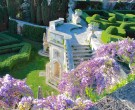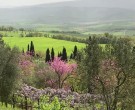> Home > What to visit > Palaces and Monuments

Villa La Foce Chianciano Terme
PALACES AND MONUMENTS
.jpg)
PHONE NUMBERS AND TIMES
Villa La Foce
Business card (vCard)
The villa, originally an inn, was bought by the Origo family in 1927. The marchioness Iris Origo commissioned the garden to the famous landscape artist Cecil Pinset , wanting to give the residence the appearance of a patrician dwelling. The garden, that is made up of three different sections put on different levels, was realized between 1927 and 1939, at different times, but without losing its harmony. The part adjacent the villa is arranged on two levels: the lower one, more simple, is enclosed by tall laurel hedges and decorated by pedestals for lemon plants; the upper one is characterized by double box tree lawns , that create an octagonal shape, at the center of which is located a travertine fountain representing two fish that hold a basin with their tails. On the sides, that coincide with the building, there’s a wisteria pergola supported by stone pillars, while diametrically opposed , there is a vegetable grotto with mixed laurel and evergreen oak essences .From this first section , you can enter, through a very narrow passage between pillars ,surmounted by two bush hammered vases, similar to the ones that are located on the perimeter wall, to the lemon garden(begun in 1933). This section takes advantage of the ground morphology, and develops itself in transversal terraces towards the hill, upsetting the classical scheme of terraces degrading along a symmetrical line. Lawns, bordered by compact box tree hedges shaped in half spheres in the corners and decorated with lemon vases, follow the natural inclination of the ground. Excluding the small pergola that clings to the wall in the narrow rose garden, the only other architectural element is the staircase that takes us to the wisteria walk and proceeds to the cypress road that ends up in the woods. The rose garden , made up of small lawns with geometrical designs, is defined by two hedges, one with lavender and the other with evergreens. In 1938, the last part of the garden was realized, connecting it to the lemon garden by huge spectacular travertine stairs. Under the stairs, decorated by vases, obelisks and a pillared balustrade, in the center, opens up a grotto , named “Blue grotto”, inside which there are seven niches. This formal garden, enclosed by a wing of cypress trees, is made up of lawns bordered by oak tree hedges. The lawns converge towards a basin , behind which stands a bench, made in travertine from Rapolano, decorated by a statue the represents Nature holding the gifts of the Earth on her shoulders. At the border of the woods there’s a small cemetery, inside which there’s a small travertine chapel enriched by a serlian arch.
STAY NEARBY
LUCCIOLA BELLA
PIENZA
The farmhouse is situated within the ‘Lucciola Bella’ Nature Riserve, south we...PODERE GELLINO
CHIANCIANO TERME
L'azienda agrituristica si trova a circa 3 km. dal centro abitato di Chianciano, immersa n...PODERE LA SELVA
CHIANCIANO TERME
The farm "Podere la Selva" is a two-storey building, comprising of two apartment...DINING & ENTERTAINMENT NEARBY
Acqua Sillene, Centro Termale
CHIANCIANO TERME
Presso lo Stabilimento Sillene, che sorge sulla collina dove gli Etruschi celebravano i lo...Acqua Santa, Parco Termale e Centro Congressi
CHIANCIANO TERME
L’acqua Santa è un’acqua termale e minerale, classificata come bicarbon...Cinema Teatro Garden
CHIANCIANO TERME
...



.jpg)

.jpg)
.jpg)
.jpg)
